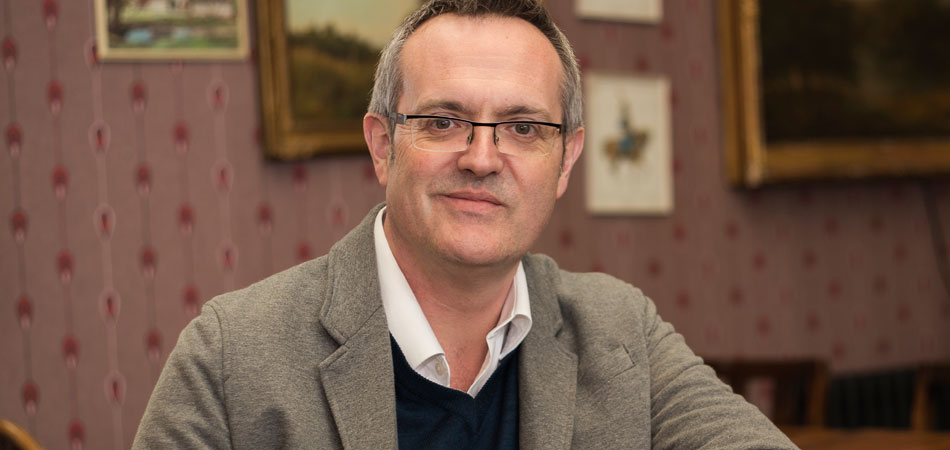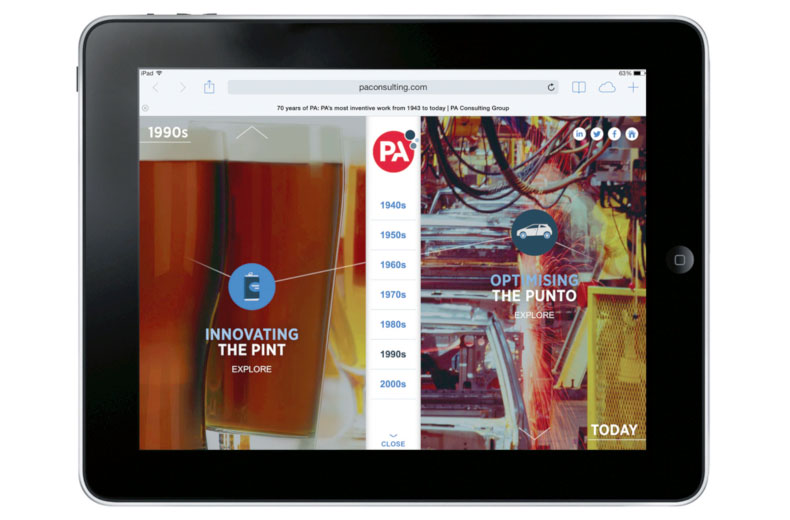
How can brands use music to overcome generational tensions?
Joanna Barnett, Strategy Director at Truant, on the power of music to bring people closer together and broaden a brand’s appeal.
Creative Director and Co-Founder at Omobono


Career to date:
2001 - Omobono (Creative Director and Co-founder)
1996 - Warman & Bannister (Creative Director)
1992 - Leopard (Art Director)
1990 - Nicklin (Art Director)
Chris Butterworth: My role is to identify how creative thinking can help clients solve business problems, whether via communication, service design or behavioural change. We hire some incredibly bright people, so my job is also to create a dynamic working environment where they can push their own boundaries and explore new ways to solve our clients’ issues.
Chris Butterworth: I originally had plans to work in TV after Art College. I freelanced in London for a short time working mainly on music videos. There’s a Level 42 video featuring my animation somewhere out there. But the reality of earning a regular income meant I took a job as a junior designer working on products as diverse as industrial vibrators (!), lawnmowers, adhesives, spectrometers and other equally glamorous stuff.
During the recession of the early 90s, the agency I was working at had a large cull of people. I was pretty much last man standing in the creative department but over the next eight years built up the business and the team to become one of the biggest B2B agencies in the UK. It was there I met my future business partners in Omobono, Ben Dansie and Fran Brosan.
We started Omobono in 2001. We made a conscious decision to focus on digital, so my role became far more about understanding the new opportunities this presented to clients. One of the particular high points was being the first European agency to win a David Ogilvy Award in the US (it also helped that we had to go to New York for the weekend to pick it up).
Chris Butterworth: When we set up Omobono, B2B was firmly in the shadow of consumer comms. There was very little press coverage of the sector other than market-specific trade magazines. Our belief was that B2B deserved the same level of insight and creativity as consumer as it made up over 50% of the UK economy.
B2B has made huge steps forward in the intervening years. There is much more engagement with business as a discipline now. Shows like The Apprentice and Dragon’s Den and high profile entrepreneurs like Mark Zuckerberg and Steve Jobs have all helped to make business more high-profile. It’s not perceived as the backwater it once was.
At Omobono, we were early adopters of digital. It works quite differently in B2B than in consumer. For example, a key priority for us is helping clients use the technology platforms they already have in place to drive engagement with their audiences.
But while there are plenty of digital agencies and quite a few B2B agencies in the world, we believe our focus on how digital specifically works for business is unique in the marketplace.
Chris Butterworth: One of my personal favorites has been the results timeline that we created for PA Consulting. I love the interaction and ability to dig around and discover hidden gems. It turns what could have been a dry list into an immersive experience. It also won us a Digital Impact Award.

Chris Butterworth: We’ve made some really talented hires at Omobono in the last year. Matthew Walko, our Head of Strategy, has been doing outstanding work. In the creative industry at large I was particularly impressed with Yann Demange’s first feature film ’71.
Chris Butterworth: I loved Pepsi’s Unbelievable Bus Shelter – cool, smart and funny. The British Airways Magic of Flying is also a great example of using data to make a story with emotion.
Chris Butterworth: Someone once said that the worst place for designers to look for inspiration is other designers. It’s certainly true for me. Books, TV, films, magazines all provide inspiration. I always find the eclecticism of the Summer Exhibition at the Royal Academy stirs the creative juices. Bob and Roberta Smith’s Letter to Michael Gove was particularly good this year. But my favourite thing is people-watching – it never fails to provide stories and inspiration.
Chris Butterworth: I’d love to have the time to get out to events and exhibitions more, but pressure of work usually gets in the way. In lieu of these, websites like Creative Review, Little Black Book and Form Fifty Five are always useful for seeing what’s trending. Being a judge on a variety of award schemes like the British Interactive Media Association’s also lets me see some of the industry’s most creative output.
Chris Butterworth: I’m always impressed with the work Droga5 create. They tell great stories around their clients’ brands and always seem to push the idea as far as it can go.
Chris Butterworth: Everyone’s at saturation point with the sheer volume of messages, content and technology they’re exposed to. And we’ve all become experts at filtering out all the noise. Everyone agrees that the disruptive model of advertising is dead so the challenge for brands and agencies is to be more meaningful and useful for their audiences. Agencies need to evolve into the service design space using their expertise in customer insight, UX and design to help customers get what they want from brands more quickly and easily.
Chris Butterworth: Technology will continue to influence the way the brands connect to customers, but the applications will be broader. When the internet of things becomes more established, household items themselves will become comms outlets for brands. When fridges run out of food, they’ll give you offers from supermarkets. Cars will do the same for petrol. Advertising will become much more moment-based nudges. The same thing will happen as wearables become more widespread.
“Everyone agrees that the disruptive model of advertising is dead so the challenge for brands and agencies is to be more meaningful and useful for their audiences”
Chris Butterworth: I’m torn when it comes to pitches. On one hand, it’s the only time that you can produce a piece of work entirely objectively without becoming embroiled in the politics and sensitivities of the client’s business. On the other, it’s a huge investment in resource – which is why it’s vitally important for agencies to vet pitches and establish the risk/reward scenario at the outset. There is unquestionably a trend to allow agencies less time in the pitch process. If it’s a creds pitch it’s manageable, but when clients are looking for creative solutions to their problems, it requires time.
I think clients need to do their homework and get under the skin of the agencies they’re calling to pitch. So chemistry meetings are always important. As is getting a good understanding of the type of work an agency produces rather than expecting them to shape to whatever is in the brand owner’s head. It’s better for clients to have a short pitch list and work alongside the agencies during the process with WIP meetings. It gives clients a much better idea of what the working relationship might be like.
Clients should also be prepared to contribute something to agency pitch costs. It signifies serious intent and makes the process less confrontational.
“There is unquestionably a trend to allow agencies less time in the pitch process”
Chris Butterworth: My favourite pitches are the ones we win! A memorable pitch was to a regional development agency held in a theatre. The stage lights were on so we could barely see the people we were pitching to (and there were lots of them). It felt like being on a marketing version of the X Factor. But when it came to questions, one person said they were worried we might be too successful and attract too many people to the region! Guess sometimes you just can’t win…
Chris Butterworth: I think the industry needs to engage with universities and colleges more. While we are much better than we were at offering learning opportunities for students, we seem to be very poor at leveraging academic input. Lots of times we reference the works of academics like Daniel Kahneman and Thaler & Sunstein, yet it’s surprising that an industry relying so much on sociology and psychology doesn’t have more connection with these academics through sponsorships or bursaries. In contrast, the tech sector is all over the likes of MIT and CalTech.
Chris Butterworth: 2015 marks the opening of our Chicago office. We have worked consistently in North America for the last ten years but we now have a serious commitment to grow the Omobono brand in the States and beyond. We believe that the combination of business, technology and creativity that we offer provides something to large US corporates that isn’t currently available, so we have a strong ambition to grow.
With so many new products and services giving customers more choice, how do you help the brands you work with encourage loyalty from their customers?
We work in B2B so the purchasing decision is very different to consumer. Much longer buying cycles, more decision-makers and larger ticket sizes make loyalty key for our clients, not just in re-purchase but in justifying their decisions post-purchase too. Making the business transparent to share the expertise within the company with customers is hugely important in driving loyalty. As is making communications part of the service by developing platforms and processes that help customers achieve their goals simply and quickly. We’re continually developing the tools, processes and thinking that help B2B clients increase their relevance to their audiences, from employees to customers to new talent.
Looks like you need to create a Creativebrief account to perform this action.
Create account Sign inLooks like you need to create a Creativebrief account to perform this action.
Create account Sign in